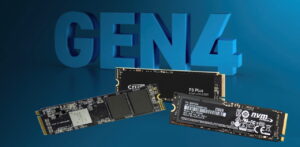In a word, yes.
In our case we had a client that wanted a large M.2 solid state drive (SSD) installed into a Dell 5550 laptop which has a PCIe gen3. The problem for us was that most current SSD’s are PCIe generation 4 and we didn’t want to be limited to only buying the older PCIe gen 3 SSDs. PCIe Gen 4 M.2 SSDs can be used on a PCIe Gen 3 system, which was good news for our client.
DIFFERENCE BETWEEN PCIe Gen 3 and PCIe Gen 4
PCIe Gen 4 can operate a double the transfer data rate of PCIe Gen 3:
| Generation | Year of Release | Data Transfer Rate | x1 Lane | x16 Lanes |
| PCIe 1.0 | 2003 | 2.5 GT/s | 250 MB/s | 4.0 GB/s |
| PCIe 2.0 | 2007 | 5.0 GT/s | 500 MB/s | 8.0 GB/s |
| PCIe 3.0 | 2010 | 8.0 GT/s | 1 GB/s | 16 GB/s |
| PCIe 4.0 | 2017 | 16 GT/s | 2 GB/s | 32 GB/s |
| PCIe 5.0 | 2019 | 32 GT/s | 4 GB/s | 64 GB/s |
| PCIe 6.0 | 2021 | 64 GT/s | 8 GB/s | 128 GB/s |
If you are working with ssds, like we are, you’re most likely looking at a device with 4 lanes. So you can take the number in the “data transfer rate” or the “x1 Lane” rates above and multiply it by 4 if you actually wanted to know the theoretical maximum that you would receive.
SPEED REDUCTION:
The PCI Express (PCIe) standard is designed to be backward compatible. This means that a PCIe Gen 4 device can operate in a PCIe Gen 3 system, but it will function at PCIe Gen 3 speeds.
In other words, if you install a PCIe Gen 4 NVMe SSD in a PCIe Gen 3 M.2 slot, the SSD will work, but it will operate at the maximum speed of the PCIe Gen 3 interface. This is because the PCIe interface will use speeds based on the lowest of the two versions for communication.
FUTURE PROOF WITH PCIe Generation 4:
It’s important to note that while the SSD will be running at PCIe Gen 3 speeds, you are unlikely to experience a significant performance impact if your device is not fully utilizing the available bandwidth. However, if you plan to upgrade your system to support PCIe Gen 4 in the future, purchasing a PCIe Gen 4 SSD now could be a good investment.




0 Comments